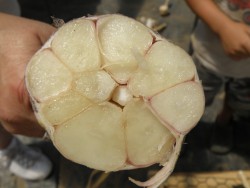Harvest Considerations for Garlic
Crystal Stewart-Courtens, Extension Vegetable Specialist
Eastern New York Commercial Horticulture

If leaves aren't the best indicator of maturity, how else can you tell? The best indicator is how the cloves are filling the wrapper leaves. Take a couple of average looking plants from each variety, and cut them in half perpendicular to the stem so that you are cutting through all of the cloves. Each clove should be tight in its wrapper leaves. If there is any give when you squeeze the bulb, or the wrapper leaves seem a little loose around the cloves the garlic will continue to expand for a little while longer (figure 1). A few of the outer wrapper leaves will probably be breaking down. That is normal.
You can also look at the shape of each clove. Cloves start out being more or less round, and expand to more of a wedge shape (figure 1). As garlic reaches full maturity, the cloves will pull very slightly away from the scape on hardneck varieties.
If you let the garlic stay in the ground too long, too many wrapper leaves will decay and the cloves will continue to expand until the garlic actually splits open. At this point the garlic becomes virtually unmarketable. Make sure that you check your garlic every few days, especially as we move into another warm stretch of weather.
As you are harvesting, keep in mind that you want to reduce the amount of water that you bring into your drying area and you want to avoid scalding your garlic during harvest. If you can harvest early in the morning (before 11 or so, depending on how hot the day is) on a dry day, then clean in the shade during the afternoon, you should have the best results possible. Allowing garlic to sit out in the field exposed to the sun can result in sun scalding, which will cause affected cloves to break down. If you have to harvest in wet weather try to remove as much mud as possible and to get any foliage you leave on the plant as dry as possible before moving it into the curing area. The higher the relative humidity is in your curing area, the slower the garlic will dry down. The slower the garlic dries, the more potential there is for disease. Dry garlic means lower relative humidity right from the start!

Upcoming Events
Vegetable Pest and Cultural Management Field Meeting for Auction Growers -- Ontario Produce Auction
July 15, 2025
Stanley, NY
This evening meeting will demonstrate pest management in fresh market vegetables in both field and greenhouse (high tunnel) vegetables, primarily for those growing for wholesale auction. A hands-on demonstration of weed, insect and disease identification in vegetables including management options. Details on each topic will focus on field observations at the farm.
Orleans Summer Vegetable Meeting, 2025
July 16, 2025
Waterport, NY
Meeting themes are pest management in a wide array of produce and best practices for pesticide use. Professor Brian Nault will cover allium leaf miner and thrips in onions, garlic, and leeks, and discuss insect challenges in other crops. Bring your questions! We'll also have a field walk that includes high tunnel tomato and cucumber.
DEC credits available: 0.5 in CORE plus either 1.25 in 1a and 23, or 0.75 in 24.
Vegetable Pest and Cultural Management Field Meeting for Auction Growers -- Finger Lakes Produce Auction
July 18, 2025
Penn Yan, NY
This evening meeting will demonstrate pest management in fresh market vegetables in both field and greenhouse (high tunnel) vegetables, primarily for those growing for wholesale auction. A hands-on demonstration of weed, insect and disease identification in vegetables including management options. Details on each topic will focus on field observations at the farm.


































